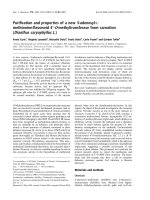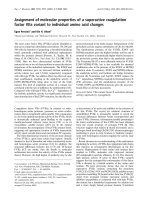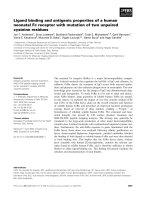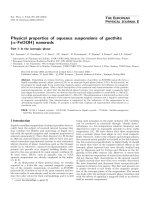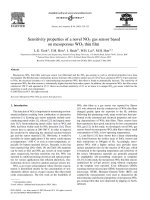physical properties minerals a ian kenyon
Bạn đang xem bản rút gọn của tài liệu. Xem và tải ngay bản đầy đủ của tài liệu tại đây (3.67 MB, 58 trang )
The Physical Properties Of Minerals
WJEC AS Geology
I.G.Kenyon
Colour 1
• Determined by the
chemical composition of
the mineral
• Minerals rich in Al, Ca,
Na, Mg, Ba and K are
often light coloured
• Minerals rich in Fe, Ti,
Ni, Cr, Co, Cu and Mn
are often dark in colour
8cm
Haematite, Kidney Ore
Colour 2
5cm
• Determined by the atomic
structure of the mineral
• Atomic structure controls
which components of white
light are absorbed or reflected
• White minerals reflect all
components of white light
• Black minerals absorb all
components of white light
• Green minerals reflect green
light and absorb the others
Pyrite Cubes with Striated Faces
Colour 3
•Colour is not particularly useful
as a diagnostic property
•Some minerals show a wide variety of colours
•Quartz can be transparent, white, pink,
brown, purple, yellow, orange and even black
•Many minerals show very similar colours
•Calcite, gypsum, barytes, fluorite,
plagioclase feldspar and halite are
commonly grey or white in colour
Colour 4
Examples of colour variation in Fluorite
Colour 5
Plagioclase feldspar
Barytes
Quartz
Fluorite
Calcite
Gypsum
All these minerals are grey or white in colour
Transparency
2cm
• When outlines of objects
seen through it appear
sharp and distinct
•A good examples is Iceland
Spar, a variety of calcite that
is used for optical lenses
•Iceland Spar also shows the
remarkable property of
double refraction
Calcite – Iceland Spar
• Determined by the atomic
structure and chemical
composition of the mineral
Translucency
1 cm
•The ability for a mineral to
let light pass through it
•Many minerals if cut thin
enough will show some
degree of translucency
•Controlled by atomic
structure and chemical
composition
Fluorite
•All transparent minerals
are also translucent
Lustre
2cm
The way in which a
mineral reflects light
Controlled by the atomic
structure of the mineral
Main types of lustre are
Vitreous
Metallic
Pearly
Resinous
Adamantine
Quartz – Vitreous Lustre
Dull/Earthy
Vitreous Lustre
Fluorite
Dog-Tooth Calcite
The mineral reflects light like glass
Sometimes glassy lustre is used instead of vitreous
Metallic Lustre
Malachite
Galena
Minerals reflect light like metals.
Metallic lustre often tarnishes to a dull lustre
Pearly Lustre
Biotite Mica
Muscovite Mica
The lustre of a pearl
or mother of pearl
Shows clearly on the
cleavage surfaces
of biotite and
muscovite mica
Also shown by Talc
and selenite (a variety
of gypsum)
Silky Lustre
1cm
The lustre of silk
Occurs in minerals with
a fibrous structure
Satin spar (a fibrous
form of gypsum) shows
this to good effect
Gypsum (Satin Spar)
Resinous Lustre
1cm
The lustre of resin
The mineral has a
grainy appearance
Sphalerite (Zinc Blende)
Sphalerite, opal
and amber show
resinous lustre
Adamantine Lustre
5mm
The lustre of a diamond
Dull or Earthy Lustre
The mineral does not
reflect light and has the
same appearance as soil.
1cm
Minerals such as galena
have metallic lustres on
freshly broken surfaces
but they tarnish to dull
with prolonged exposure
to the atmosphere
Limonite has a dull or earthy lustre
Streak
The colour of a mineral’s powder
Obtained by rubbing a mineral
specimen on an unglazed white
porcelain tile
Useful for identifying
metallic ore minerals
Silicates generally do not mark
the tile and have no
streak
White minerals streaked on a
white tile will have a white streak
Haematite gives a
cherry red streak
Any minerals harder than the tile
(6) will scratch it
Streak 2
Malachite – pale green
Galena – lead grey
Haematite – cherry red
Iron Pyrite – greenish black
Sphalerite – pale brown
Limonite – yellowish brown
Metallic Ore Minerals – Characteristic Streaks
Relative Density
Measured relative to an equal volume
of distilled water at 4 degrees centigrade.
1 litre = 1000g (1kg) 1 cubic centimetre = 1g
Controlled by the atomic weight of the constituent atoms
(chemical composition) and the packing (atomic structure)
A useful property for identifying metallic ore minerals,
these usually have relative densities over 5.0.
The only non-metallic mineral which
is quite dense is barytes (4.5)
Most of the silicate minerals have
densities between 2.5 and 3.2
Relative Density- Some Examples
Kyanite 3.5-3.7
Gold 12.0-20.0
Fluorite 3.2
Iron Pyrite 4.9-5.2
Haematite 4.9-5.3
Gypsum 2.3
Hardness
Measured on Moh’s scale from 1.0 (softest) to 10 (hardest)
Talc 1.0
Diamond 10.0
Scale was devised by measuring the amount of noise and
powder produced from rubbing a mineral on a metal file
Moh’s Scale of Hardness
10 Diamond
9 Corundum
8 Topaz
7 Quartz
6 Orthoclase Feldspar
Note diamond is over 30 x harder than corundum
Moh’s Scale of Hardness
10. Diamond
7. Quartz
9. Corundum
8. Topaz
6. Orthoclase Feldspar
Moh’s Scale of Hardness
5 Apatite
4 Fluorite
3 Calcite
2 Gypsum
1 Talc
From 1 through to 9 on the scale, hardness increases in equal steps





